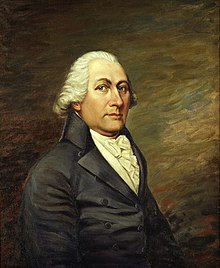
Back جون لانجدون ARZ جان لانقدان AZB John Langdon German John Langdon Spanish جان لانگدان Persian John Langdon French ג'ון לנגדון HE John Langdon ID John Langdon (politico) Italian ジョン・ラングドン (政治家) Japanese
John Langdon | |
|---|---|
 Portrait by Hattie Elizabeth Burdette, 1916. | |
| 2nd President of New Hampshire and 3rd Governor of New Hampshire | |
| In office June 5, 1810 as Governor – June 5, 1812 | |
| Preceded by | Jeremiah Smith |
| Succeeded by | William Plumer |
| In office June 6, 1805 as Governor – June 8, 1809 | |
| Preceded by | John Taylor Gilman |
| Succeeded by | Jeremiah Smith |
| In office June 4, 1788 as President – January 22, 1789 | |
| Preceded by | John Sullivan |
| Succeeded by | John Sullivan |
| In office June 1, 1785 as President – June 7, 1786 | |
| Preceded by | Meshech Weare |
| Succeeded by | John Sullivan |
| President pro tempore of the United States Senate | |
| In office November 5, 1792 – December 2, 1793 | |
| Preceded by | Richard Henry Lee |
| Succeeded by | Ralph Izard |
| In office April 6, 1789 – August 9, 1789 | |
| Preceded by | Position established |
| Succeeded by | Richard Henry Lee |
| United States Senator from New Hampshire | |
| In office March 4, 1789 – March 3, 1801 | |
| Preceded by | Seat established |
| Succeeded by | James Sheafe |
| Personal details | |
| Born | June 26, 1741 Portsmouth, New Hampshire, British America |
| Died | September 18, 1819 (aged 78) Portsmouth, New Hampshire, U.S. |
| Political party | Pro-Administration Anti-Administration Democratic-Republican |
| Signature | |
John Langdon Jr. (June 26, 1741 – September 18, 1819) was an American politician and Founding Father from New Hampshire. He served as a delegate to the Constitutional Convention, signed the United States Constitution, and was one of the first two United States senators from New Hampshire.
As a member of the Continental Congress, Langdon was an early supporter of the Revolutionary War. He later served in the United States Congress for 12 years, including as the first president pro tempore of the Senate, before becoming president and later governor of New Hampshire. He turned down a nomination for U.S. vice presidential candidate in 1812.